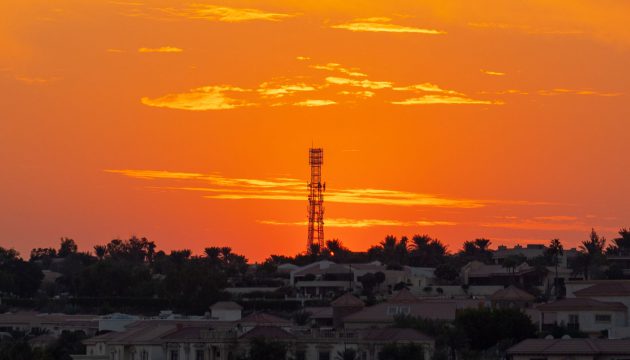Start fueling before the onset of fatigue
Most marathon runners know about the wall. It strikes later in the race — around mile 18 — and turns your legs to stone and your brain to mush. Physiologically, what happens is an athlete can consume all the available glycogen in the body and find themselves running low on energy. The mind begs for an easier way out: stop running now! Of course, dropping out of the race is no more of an option for an ambitious athlete than it is for a mobile network operator (MNO). So how can both avoid running out of gas before the finish line?
Sure, there are quick fixes during the race. But the best plan for athletes and telecommunications providers involves greater efficiency and preparation long before race day. Together, these two strategies enable the transition to alternative energy sources and the ability to go the distance.
Preparing for a pace that keeps accelerating
In the future, a typical telecommunications user could consume 100 times more data. More people will be working or studying from home. Mobile networks may need to transmit up to 1000 times more data per area than before[1]. The information we have now suggests that 5G base stations using technologies such as massive MIMO will consume many times the energy of current LTE equipment.
[1] https://www.metis2020.com/wp-content/uploads/deliverables/METIS_D8.4_v1.pdf
The sources of increased traffic in a 5G world
MNOs are already buying licenses for additional spectrum and starting to build out their 5G networks. New 5G equipment will in many cases be more efficient than the old 4G and 3G hardware it replaces per bit transferred. Yet these efficiency gains will be offset by a steady increase in the amount of data the mobile network will have to handle.
There are three main use cases that 5G is envisioned to cover.
- Enhanced mobile broadband (eMBB)
Subscribers will have much faster broadband while also enjoying better and more seamless network coverage, whether stationary or on the move. People will access video and streaming over the mobile network as cloud services gain in speed and popularity. This translates to more users, more data, and much higher transfer rates. - Massive machine-type communications (mMTC)
By 2025, IoT devices are expected to generate more than half of the world’s total data. The mobile network capacity needed to transmit all that data will be around triple of what current 4G LTE networks can handle. These devices will be cheap, low-energy, and everywhere. We’re talking about things like the connected refrigerator that can order your favorite groceries from a delivery service and then auto-update its current inventory after re-stocking. - Critical machine-type communications requiring ultra-reliable, low-latency communications (URLLC)
Self-driving cars are an excellent example of devices that will require ultimate reliability and low latency to perform as promised. Not only will existing services become more reliable with 5G, entirely new ones will be possible.
Sustainability goals have already been set
In Europe, keeping costs in check and responding to climate change have become critical challenges for telcos & towercos. The EU’s Climate and Energy Framework, for instance, has set a goal for 2030 of lowering greenhouse emissions by 40% compared to 1990 levels. National governments will accordingly expect telecommunications providers to make good on their promises to reduce carbon emissions.
Some top-tier MNOs have already announced their own ambitious sustainability goals. One has for instance stated in its 2019 sustainability report that it plans to lower greenhouse gas emissions 50% by 2025. Furthermore, 100% of the electricity it purchases is to come from renewable resources by the same deadline.
Another operator has declared its support for limiting climate change to 1.5 degrees Celsius. To this end, it is targeting an 85% reduction in energy consumed per unit of data traffic by 2025. The switch to 100% renewable energy is envisioned by 2030.
These goals will require massive investments in energy saving technologies from all MNOs if they are to be achieved within the planned time frame. These are difficult changes to implement even in the best of economic times. Nevertheless, CEOs understand the devastating impact that inaction would have on their businesses — and the climate.
Regional differences across Europe
There are however limits to what can be done in many parts of Europe. Dense urban environments, for instance, can prove difficult for installing large solar upgrades to existing base stations. Another factor to consider is that some countries such as Germany may be able to cover most or all of their energy needs with renewables in the future. In this case, off-grid solar no longer offers an advantage regarding decarbonization. Saving energy, however, may still remain profitable as energy prices continue to rise. In Spain, taxes on grid-connected solar installations have been lifted, and the country has experienced a renewed solar boom.
COVID-19 is throwing a wrench in the works
Lockdowns to combat the global pandemic present a challenge to the telecommunications industry. Many operators have purchased spectrum and gained approvals to build out their 5G infrastructures. Some are finding it difficult to get cranes and crews to sites in time to meet regulator deadlines.[2] Other companies will also be affected by the expected global recession. The new services the 5G network hopes to enable and monetize depend on businesses that may not all survive the coming months and years. All of these factors make it very clear: If 5G is a race, it is a marathon, not a sprint. That makes efficiency even more important.
[2] https://spectrum.ieee.org/tech-talk/telecom/wireless/the-pandemic-has-slowed-wireless-network-buildouts
Options for saving energy
In this environment, total cost of ownership is more important than ever. If efficiency does not improve fast enough, the amount of energy demanded by new services will exceed what MNOs and towercos can profitably supply. Of course, no one expects to hit that wall, and there are many ways to avoid it. Just as a runner can work on the efficiency of their stride and train the body to more easily switch to burning fat over glycogen, so too can operators improve their network operations and use alternative energy sources. Runners increase their “metabolic flexibility” by training their bodies to burn fat. For MNOs and towercos, we’re talking about hybrid systems, power upgrades, and energy optimization. In both cases, the work needs to be done long before the situation becomes critical.
The smartest investments are ones that reduce OPEX long-term while also offering a rapid return on investment. Energy saving measures do both, making them an excellent option. They can pay for themselves in as little as two year’s time. What’s more, as energy prices rise, savings increase proportionally.
Hybrid power systems
Hybrid power systems present an outstanding opportunity to reduce OPEX and claw back some of the profits erased by rising energy costs. When we consult our customers on energy saving solutions at Delta, there are several types of systems we recommend depending on the scenario. Solar can be a primary source of power for sites located off the grid, or simply provide support as an add-on to grid-connected installations. I outline the main options that are available below.
- Solar add-ons
A solar upgrade results in a hybrid system, allowing an existing site to profit from renewable energy. A single design can work for many different site types, simplifying maintenance and spare parts management. A solar add-on lowers CO2 emissions and operating expenses. All you need is the space to install it and a modest investment. - Power conversion efficiency upgrade
Retrofitting rectifiers is easy to do and starts saving you a lot of energy and money immediately upon installation. Take for example the common scenario of a network running popular rectifiers rated at 96% efficiency. Switching to ultra-efficient rectifiers with true 98% efficiency means much more to an operator than just a 2% efficiency improvement! In fact, what you are doing is reducing conversion losses by a whopping 50%. This is low hanging fruit that pays for itself very quickly. The only question, really, is how fast can you get it done. - On-site energy storage
Energy is generally the most expensive when the mobile network is experiencing peak loads. One way to save money is to generate or collect energy when it is cheaper and store it for later use when rates on the grid are highest. What’s more, most sites will already have a lead-acid battery installed. There is an additional environmental benefit from replacing a chemistry that uses a heavy metal with lithium-based batteries. - Optimize energy consumption
There are a number of ways to manage energy consumption. One option is to choose equipment that can operate reliably across a wider range of temperatures with passive cooling or just fans, saving the electricity otherwise consumed by air conditioning. And if that is not possible, we recommend implementing smart cooling methods that optimize the way the environmental control devices operate
The path forward
The nature of the mobile game is changing. In the past, efforts to save energy across the radio access network were a matter of weighing additional CAPEX against OPEX savings and simply making the best financial decision. Now, that equation has fundamentally changed. It requires a corresponding change in strategy. OPEX will continue to have a greater impact on total cost of ownership, turning the race to 5G into a test of endurance.
Operators who are too slow to switch to a more efficient stride and more sustainable ways of powering their networks may find themselves hitting the wall — or dropping out of the race entirely. Luckily, this can be avoided. And all operators have to do is to decide which energy saving solutions are the best choices for their networks and invest in them now.



